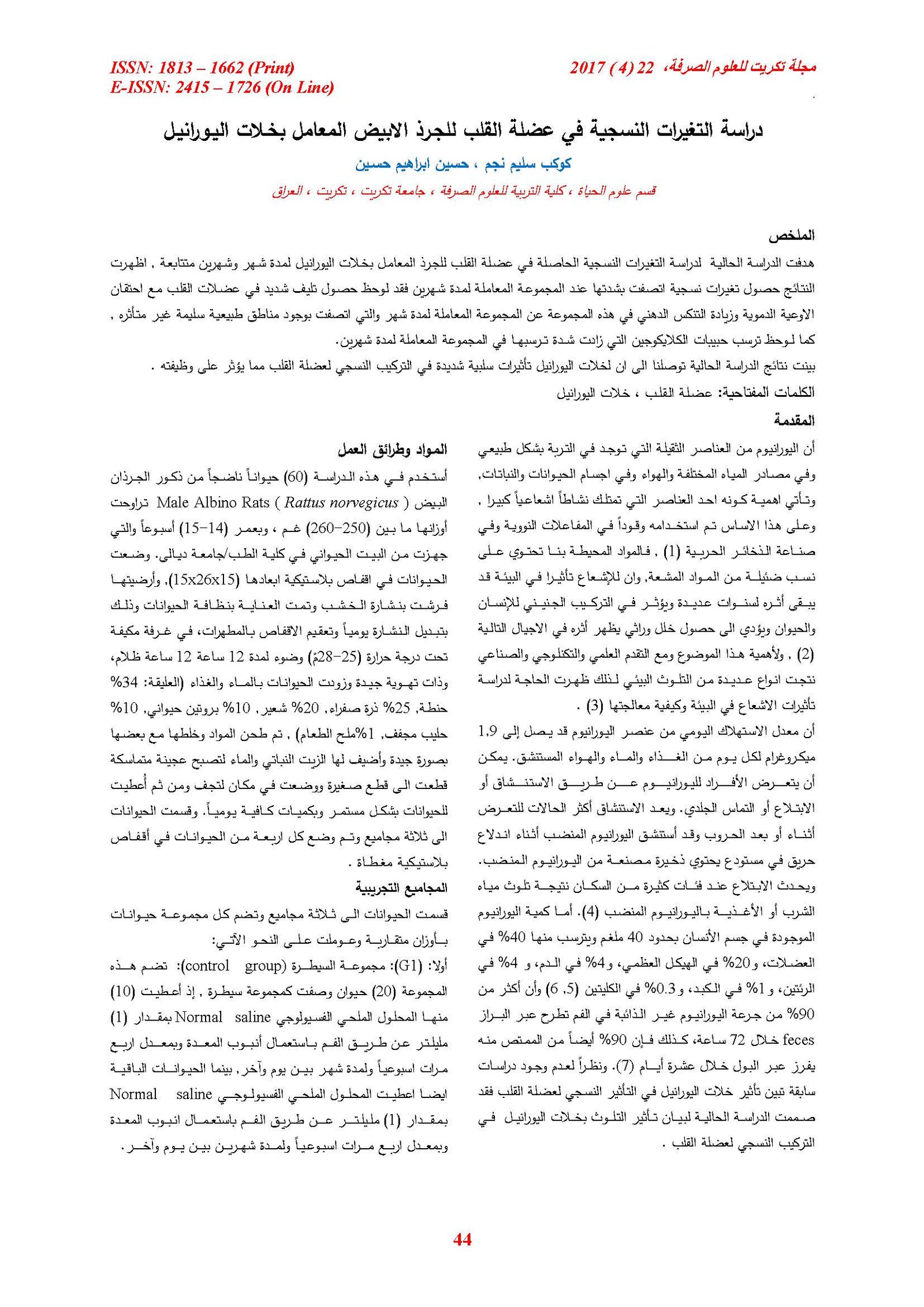Histological changes study of the White rat heart muscle treated with Uranyl acetate
Main Article Content
Abstract
The present investigation aimed to study the histological changes of heart muscle treated with Uranyl acetate for one & two months. The results showed that there was histological changes in the heart muscles , these changes were more sever in animal group treated for two months. Since severe fibrosis was seen with congestion of blood vessel as wear of an increment of fatty degeneration compared with group one which was treated for one month and characterized with the presence of normal not effected region .
The present study we may concluded that, Uranyl acetate induced severe negative changes on heart muscles which may lead to effect on its function .
Article Details

This work is licensed under a Creative Commons Attribution 4.0 International License.
Tikrit Journal of Pure Science is licensed under the Creative Commons Attribution 4.0 International License, which allows users to copy, create extracts, abstracts, and new works from the article, alter and revise the article, and make commercial use of the article (including reuse and/or resale of the article by commercial entities), provided the user gives appropriate credit (with a link to the formal publication through the relevant DOI), provides a link to the license, indicates if changes were made, and the licensor is not represented as endorsing the use made of the work. The authors hold the copyright for their published work on the Tikrit J. Pure Sci. website, while Tikrit J. Pure Sci. is responsible for appreciate citation of their work, which is released under CC-BY-4.0, enabling the unrestricted use, distribution, and reproduction of an article in any medium, provided that the original work is properly cited.
References
1. Agency for Toxic Substances and Disease Registry (ATSDR). (1999). Toxicological profile for uranium (update); Atlanta, G.A: Public Health Service.
4. World Health Organization (WHO). (2004). Back ground document or development of WHO Guidelines for drinking- water quality. Fax: +41 22 791 4805; Email: permission@Who.int .
5. Igarashi, W.; Moss, M. A. & Singh, O. W. (1987). The role of uranium accumulation in different body tissue, J. Bioll Chem; 173:737-748 .
6. Fulco, C.E.; Liverman, C.T. and Sox, H. C. (2000). Gulf War and Health. Vole 1. Depleted uranium. pyridostigmine Bromide, Siren vaccines. Committee on Health effects Associated with Exposures during the Gulf War. Division of Health promotional and disease prevention. Institute of
Medicine. National Academy press. Washington, D.C. ISBNO - 309-07-178-X .
7. International Commission on Radiological Protection (ICRP). (1995). Age - dependant doses to members of the public from intake of radionucliutides: part 3. ICRP publication 69.Ann ICRP 25; 57-74 .
8. Al-Shemmary, B. F. H. (2005). Histological and biochemical effects of uranyl acetate on male reproductive system in rat. pH. D. Thesis. College of Veterinary Medicine, University of Baghdad .
9. Bancroft, J.D. and Stevens, A.A. (eds), (1996). Theory and practice of Histological Techniques, 1stedn., Churehill Livingstone, Edinburgh, London. pp: 236-370 .
10. Drury, R.A.B. & Wallington, E.A. (1980). Carleton's histological technique Ed. 5 Oxford University Press, Oxford, UK.
11. Duncan, R.C.; Knap, R.G. & Miller, M.C. (1983). Introductory biostatistics for the health sciences, A Wiley Medical publication, John Wiley and Sons, London. pp: 161-179 .
12. NIEH, (1977). Human health and the environment ,some research need- report of the second task force for research planning in environmental health Us Department health education and welfare, public health service, National institutes environmental
health science Washington, DC, US, Govt printing office (DHEW publication No. NIH: 77-1277.
14. Jagtap, A.G.; Shirke, S.S. & Phadk, A.S. (2004). Effect of polyherble formulation on experimental models of inflammatory bowel disease. J. Ethnopharmacol; 90: 125-204.
15. Lopez, A. (2014). Pathology of Muscle. UPEI university Island . http://people upei. Ca/lopez .
16. Weber, K.T. (1997). Fibrosis, a common pathways to organ failure; angiotensin II and tissue repair. Semin Nephrol;17;467-491.(Medline).
17. Pietrangelo, A.(2010). Hereditary hemochromatosis: Pathogenesis, Diagnosis, and Treatment. Gastroenterology.; 139: 393-408 .
18. Oliveira, H. C.; Cosso, R. G.; Alberici, L. C.; Maciel, E. N.; Salerno, A.G.; Dorighello, G.G.; Velho, J.A.; Faria, E.C. & Vercesi, A.E. (2005). Oxidative stress in atherosclerosisprone mouse is due to low antioxidant capacity of mitochondria. FASEB J;19(2):278-280 .
19. Vercesi, A. E.; Kowaltowski, A. J.; Oliveira, H.C.F. & Castilho, R.F. (2006). Mitochondrial Ca+ transport, permeability transition and oxidative stress in cell death: implications in cardiotoxicity, neurodegeneration and dyslipidemias. Front Biosci; 11:2554-2564.
20. Bucci, M.; Borra, R.; Nagren, K.; Parkka, J.P. & Del, R. Y. (2011). Trimetazidine reduces endogenous free fatty acid oxidation and improves myocardial efficiency in obese human .
21. Wende, A.R. & Abel, E.D. (2009). Lipotoxicity in the heart. Biochim Biophy Acta.
22. Lopez, A. (2004). General structure, congenital defects and degenerative diseases of muscle. university of Prince Edward Island, Canada.
